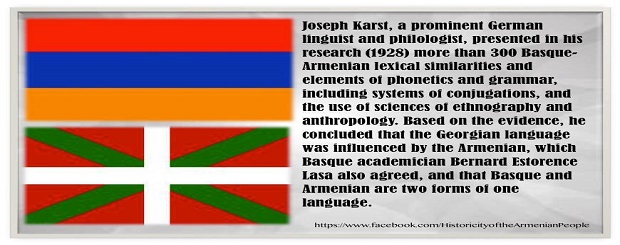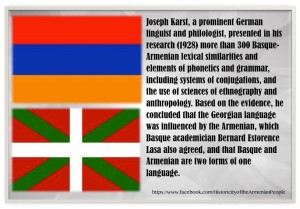
07 NOVEMBER 2015
1499534_10151928822388043_1713872361_n
At the end of past century an English scientist Edward Spencer Johnson absolutely accidentally made a very interesting discovery. Being already a well-known basqologist, Johnson studied Armenian in Parisian “Ecole Special”, in the class of the famous philologist Ogust Career. The result was highly unexpected: already after 2 months studies Johnson noticed that many Armenian words are practically identical in Basque language. His own cogitations about these lexical coincidences Johnson published in journal “Euskera” (“Basque language”) under an intriguing headline “Basque words in Armenian”, in 1884. The list mentioned the parallels between more than fifty words. It was as thunder in clear sky for the scientists , who already, for a long time supported basque-georgian hypothesis.
945548_10151471442323043_1308436392_nFor example, (with transcriptions) BS- char «bad, evil» – ARM. char «bad, evil», BS. anti «from there» – ARM. anti «from there», BS. ais «wind» -ARM. ais «wind», BS. zati «separate» – ARM. zati «separate», BS. tegi «place» – ARM. tegh «place» .….
The second important discovery was made later. In 20ths basque philologist Bernardo Estornes Lasa, a prominent scientist and academician, collected basque folklore items in Rapcal valley, in the east part of province Navarra. There, in the village Isaba, near the east border of Navara, Estornes Lasa wrote a local legend about how the village Isaba was founded by the Armenians, the first inhabitants of Navarra and the ancestors of basque people.
The legend tells that leader of basques called Haytor arrived from Armenia with his seven sons and in their honour founded seven settlings in Navarra. It is also said that that ancestor of basques knew the secret of processing metal. Subsequently, the ancient manuscript was found in the archives of the village, a historic chronic, which confirmed the spoken legends. Highly notable that in basque language Isaba is translated as “The trace of ancestors”. Although this can seem absolutely incredible, but the fact remains the fact, in village Isaba exists a road, which carries the name Erminia (Armenia), in honour of the first colonizers of Navarra.
601790_10151471459583043_1312972933_nIn basque language the name of their ancestor Haytor means “Received from Haya” which exactly corresponds to armenian ’hay tor’ (“a Grandson of Armenian”). The well-known german scientist Joseph Karst mentioned that too. It was also proven that the famous ancestor of the Armenians Hayk indeed had a grandson, whose name was Pask (in some Armenian dialects Bask). The first time the possible relationship between Armenian name Pask and etnoname of Basques was indicated by N. Marr. It’s interesting that in Basque language an expression ‘haytoren seme’ exists which means “the son of Haytor”.
All these facts were only the top of iceberg of the greatest secret of the european civilization. So, the theory of the armenian origin of the oldest people of Europe has its deep roots in the historical memory and found its reflection in basque written sources. As far back as XVI-XVIIcc., the founders of basque national historiography Garibay, Andres de Posa and Baltasar de Echave considered Armenia the prehomeland of basques and tried to prove this on the basis of basque-armenian toponyms… Araks (The name of a river in Armenia and in the Land of Basques) and the name of basque mountain Apalar, which was repeatedly compared with the famous biblical Ararat. Moreover, de Posa confirmed that basques are from Armenia. He even elaborated that the city Taragona meant “commune of shepherds” had its connections with Armenian Taron, the ancient form is – Tarawna.
253234_10151471441688043_568806408_nA spanish historian of XVII century Gaspar Eskolano , in his book about the history of the city Valencia (1610), wrote that after the Worldwide flood the patriarch Tubal and his people disembarked on the east seaside of Spain and that they spoke Armenian.
919316_10151471441738043_1430337969_o Besides, Gaspar Eskolano described the place, where, according to the legends, the remains of Armenians – the first inhabitants of Spain were buried. Now, on those places, on the territory of modern Catalonia, churches can be found, the area was considered sacred.
All this information remained long in darkness because the topic wasn’t analyzed with the help of Armenian language. When German linguist Joseph Karst proceeded to detailed study of basque-armenian theory, the hypothesis about georgian origin of basques was firmly motivated. Georgian words in Basque language were obviously borrowings from Armenian, this was indicated by basque academician Bernard Estorence Lasa.
945548_10151471442323043_1308436392_nIn 1928 Joseph Karst published the results of his studies, under headline “Alarodians and protobasques”. The Book was issued in Vein in French , and caused enourmous resonance in scientific world. In the given work Karst presented more than 300 basque-armenian lexical, phonetic and grammatical similiarites, including systems of declension, conjugations and others. Karst came into conclusion that Basque and Armenian languages are two varieties of one linguistical type, which he named Alarodian. Besides, Karst handled the ethnography and the anthropology of Basques and Armenians which brought new data and proofs.
603694_10151471438148043_1047812370_n In 1993 Armenian centre of Yerevan state university founded armenian-basque international scientific journal “Araks”, which is edited by armenologists and basqologists from different countries of the world.
Some examples on Armenian – Basque similarities
BS.’elki’(exit)-ARM.’elk’(exit)
BS.’ete’(if)-ARM.’ete’(if)
BS.’jaraunsi’(to inherit)-ARM ‘jarangel’(to inherit)
BS.’muruncha’(snarl)-ARM.’merenchots’(snarl)
BS.’murtsa’(fist)-ARM.’murts’(fist)
BS.’orma’(wall)-ARM.’vorm’(wall)
BS.’tegi’(place)-ARM.’tegh’(place)
BS.’toil’(weak)-ARM.’tuil’(weak)
BS.’laino’(size,breadth)-ARM.’lain’(broad)
BS.’irurden’(third)-ARM.’erordn’(third)
BS.’astadun’(weighty)-ARM.’hastatun’(strong, steadfast)
BS.’astatu’(to prove)-ARM.’hastatel’(to prove) .
In the Armenian Highlands and in Baskonia there are enourmous amounts of toponyms, which sometimes get to the level of simple repetition, such as
Ashtarak (a town in Armenia) – Astarak (a settlement in south of France).
Goris (a city in southeast Armenia) – Goris (a settlement in Baskonia).
Deba (a river in north Armenia) – Deba (a name of a river in Baskonia).
Shubria (The ancient name to provinces Sasun) – Shuberoa (tha name to basque province in France).
Araks (a famous river in Armenia) – Arakses (a famous river in Baskonia).
Aran (the name of terrain in Armenia) – Aran (Wide-spread toponym in Baskonia).
Karkar (the name of terrain in West Armenia) – Karkar (famous toponim in Baskonia).
As it was already noted above, in basque national tradition the prehomeland of basques was considered Armenia, besides, different sources noted that the strangers from Armenia knew the secret of processing metal.
For the matter of that highly notable self-designation of basques ‘euskaldun’, which derives from the root of element ‘eusk’, in different dialects having different forms – eusk, usk, esku, asketic. The root is etymologicaly connected with armenian word ‘voski’ “gold”, existing in dialects with different variants: iski, veske, aske, ioski. The Armenian word voski “gold” has alterred in proper name ‘Voskan’, which means “having gold” and reminds the ethnic name of basques ‘baskon’, and in latin sources fixed as ‘vaskon’. At the period of so-called Urartian kindom (in Armenian – Araratyan Kingdom) in south-east side of the lake Van, which was the crib of Armenian people, that part of the land is called ’Khubushkia’ by the Armenians which means “valley of usks” that is to say “valley of gold “. And highly notable that in medieval armenian sources Khubushkia, “valley of usks” or ” golden valley” already had other name – ‘Hayots dzor’ which means “Armenian valley”. On the other hand, the Ushkiani mountains are mentioned in urartian inscriptions on the side of lake Urmia. At the period of Strabon, the Ushkiani mountains already were identified as ‘Armenian mountains’, but in Armenian sources they are known as ‘Voskean’ -”golden”.
All these facts allow us to draw a conclusion that for our ancestors the word “gold-miner” and “Armenian” were synonyms, which is also evidenced by basque national legends.
In conclusion, there was a genetic study done in different regions of Armenia, that detected that the characteristic genetic code prevalent in Welsh, Basques and Irish, called the Atlantic Modal Haplotype, is also present in Armenian population of Syunik and Artsax. These are two Armenian provinces predominantly isolated in the mountains, which precluded genetic admixture with neighboring ethnic groups and nations». The Armenian modal haplotype is also the modal R1b3 haplotype.

